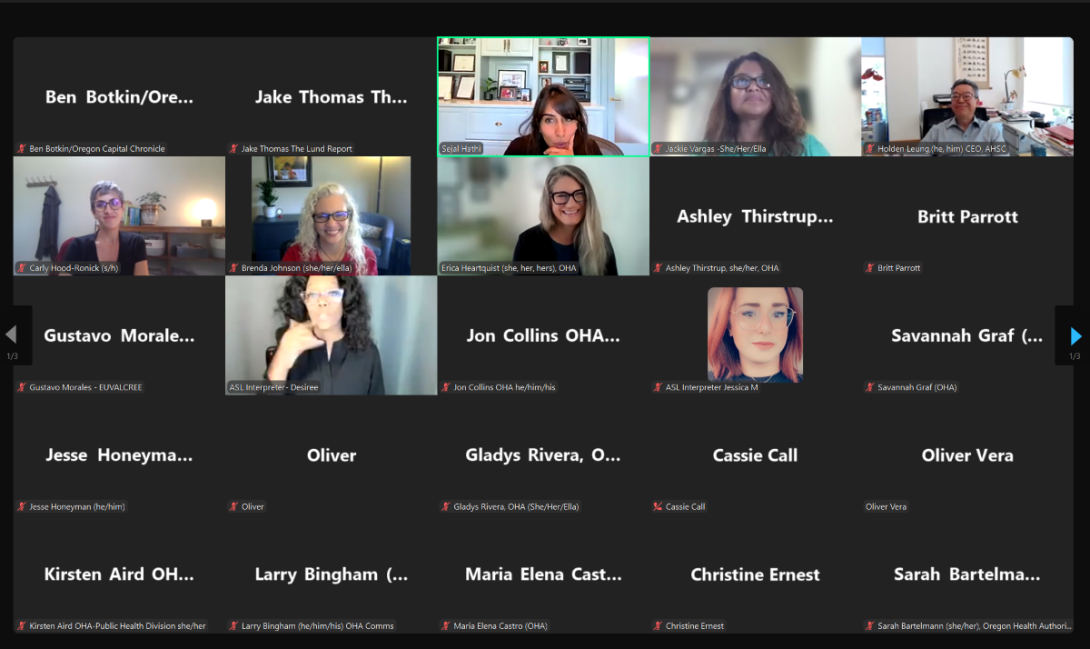
Black Oregonians under 75 are twice as likely to die from treatable causes than white Oregonians. Black children are nearly three times as likely to be boarded in a hospital emergency department for more than 24 hours. And people of color in the state continue to experience poorer care and health in other measures, too.
Six months after Sejal Hathi took over leadership of the Oregon Health Authority vowing to renew the agency’s efforts to address longstanding inequities and eliminate health disparities in the state, the agency has released a plan laying out how it intends to reach that goal by 2030.
Shared in a press conference Tuesday, the plan was light on specifics and to a significant degree described existing agency initiatives. But Hathi also promised significant progress by 2027 on access to behavioral health, the cost of health insurance and other issues that have long vexed Oregonians.
Moreover, she said, that progress will be reported in an online dashboard soon to be made public to provide a central view of the state’s different initiatives.
“Everything that we do is being tracked accordingly to ensure progress on these plans,” she said.
“We were fast, and we eliminated a lot of bureaucracy to get resources where they needed to go. We communicated often and with clarity. Even though we knew we didn’t have all the answers, whenever possible we found alignment around a common cause.”
The strategic plan follows up on a goal set by the agency in 2020 to put an end to some residents having poorer health or less access to care because of their race, economic status, where they live or other social factors.
Among other things, the 42-page strategic plan promises that by 2027 more Oregonians who need behavioral health treatment will be able to receive it and fewer residents will be uninsured because of cost.
Health inequities, Hathi said Tuesday, are reflected in how Black, American Indian and Alaska Native people “live sicker and die younger than the rest of the community.” Rural Oregonians suffer higher rates of depression and suicidality yet have fewer options for care and people released from prison or jail are at high risk of dying from a drug overdose, she added.
“Achieving health equity means establishing a health system where every person in Oregon — no matter their race, their language, their disability, their immigration status, their gender identity or other circumstances — can reach their highest potential and highest level of well being,” Hathi said.

The plan includes several tasks and goals that lawmakers previously assigned to the health authority, such as increasing Oregon’s number of high-acuity behavioral health treatment beds, stopping hospitals from collecting debts from poor patients, slowing annual rises in health care spending, making overdose reversal medication widely accessible and others.
The plan does not include specific numeric targets to measure the health authority’s success.
But Hathi said the online dashboard that will be published in coming weeks will, for instance, show how many beds the health authority has funded in region’s across the state and how that compares to the goal in a study released in June finding that the state needs up to 3,700 adult mental health and substance use treatment beds.
Brenda Johnson, the CEO of southern Oregon-based safety net clinic La Clinica, said during the media briefing that “eliminating health inequities is complex and often painful.” But Johnson, the chair of the authority’s oversight board, said she was optimistic and said that Oregon’s success during the pandemic in distributing the COVID-19 vaccine to communities of color showed the way forward.
“We were fast, and we eliminated a lot of bureaucracy to get resources where they needed to go,” she said. “We communicated often and with clarity. Even though we knew we didn’t have all the answers, whenever possible we found alignment around a common cause.”
Plan took time
The plan has taken years to produce, interrupted by the pandemic that put many agency efforts on hold. The agency set the 2030 goal five years ago and has pursued a strategic plan in conjunction with listening sessions and other engagement involving hundreds of people.
Earlier on Tuesday, at a meeting of the agency’s oversight body, the Oregon Health Policy Board, Hathi said the strategic plan features five “goal pillars:”
- Expanding workforce to build a behavioral health system “that works for every child, teen, adult and family experiencing mental illness or harmful substance use.”
- Ensuring that every person in Oregon can easily access affordable health care with a priority on “communities most harmed by health inequities.” The goal includes maintaining the state’s already near-universal insurance coverage rate and helping community groups enroll people in plans.
To support this goal, Hathi told her board the authority will strengthen health insurance network adequacy, do more to prevent rural facility closures and enforce financial assistance laws that are causing people to fall into medical debt.
- Improving the health of families and environments by making preventative services and support for new parents and families more available before and after birth. The goal also calls for making safe housing more available as well as healthy food and reducing the adverse effects of climate change, such as emergency department visits from exposure to wildfire smoke.
Hathi told the board that the goal means “lowering the rates of congenital syphilis, severe maternal morbidity and childhood lead poisoning, and tackling misinformation and improving uptake of childhood vaccinations against preventable infectious disease.”
- Working with Oregon’s nine federally recognized tribes, the federal Urban Indian Health Program and others to promote health in Native communities. The goal calls for health services for this population to be “rooted in traditional and culturally specific practices.”
Enhancing the authority’s internal efforts to address racism. The goal includes increasing the percent of employees who have participated in anti-racism training and developing “fair and consistent standards for accountability within the agency for when harm is done.”
“Health equity is everyone’s job. It’s not just OHA’s job. It’s not just the government’s job. It’s an all-of-society mandate and effort.”
Wide-ranging effort
The health authority’s strategic plan uses a definition of health equity developed by the Oregon Health Policy Board in 2019, which was accompanied by a call for the “equitable distribution or redistribution of resources and power.”
The release of the plan comes weeks after Hathi terminated Leann Johnson, the longtime director of the agency’s Equity and Inclusion Division. The move sparked criticism by agency employees and allies of Johnson and reports of poor morale inside the agency.
Rosemarie Hemmings, a Beaverton social worker and member of the board, asked Hathi about potential morale issues among staff. Hathi responded that she was engaging in team and trust-building activities while also engaging staff concerning the hiring of Johnson’s permanent replacement.
Dr. Tony Germann, a West Linn physician and board member, asked about what the next steps are for the equity plan.
Hathi responded that staff would be identifying commitments from commercial insurers, hospital systems and large private sector companies in the state to plan.
“Health equity is everyone’s job,” she said. “It’s not just OHA’s job. It’s not just the government’s job. It’s an all-of-society mandate and effort.”